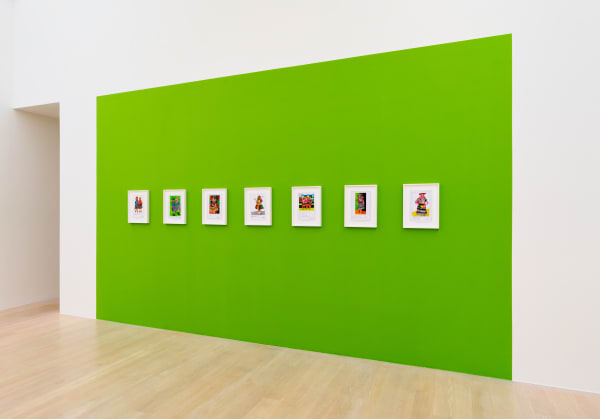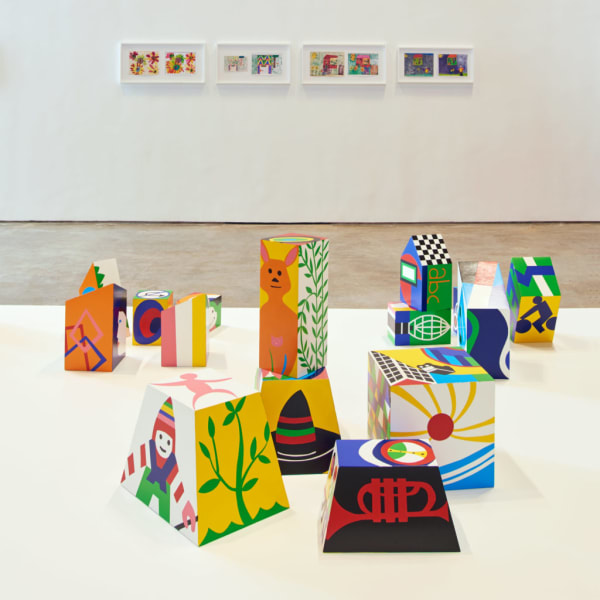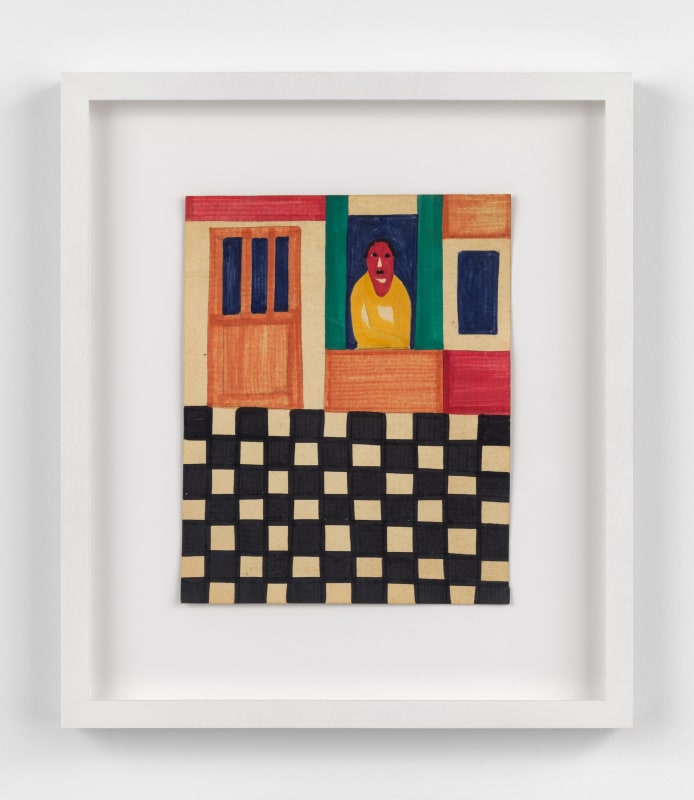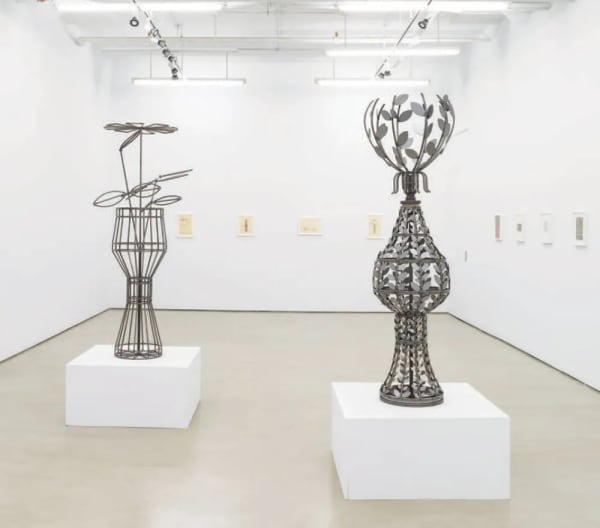Teresa Burga
-
Biography
Teresa Burga (1935–2021) was born in Iquitos, Peru. A pioneer of Conceptualism in Latin America, Burga’s practice encompassed drawing, painting, sculpture, multimedia installations, and displays of analytical data and experimental research. She studied at the School of Visual Arts at the Pontifical Catholic University of Peru and contributed significantly to the local avant-garde beginning in the mid-1960s. In 1966, Burga formed part of the group Arte Nuevo (New Art Group), a collective of artists dedicated to advancing the genres of Pop, minimalism, Op Art, and happenings in Peru.
Burga’s figurative paintings and works on paper incorporate mass media iconography and commercial aesthetics into psychically charged compositions, often focused on women and accompanied by bold, colorful geometric patterns. Questioning traditional artistic authorship, in 1968 she devised a series of reconfigurable sculptures emblazoned with graphic signs and recognizable icons, which were meant to be produced by anyone following schematic diagrams and rearranged according to play and chance.
Traveling to the United States in 1968 on a Fulbright scholarship, Burga studied at the School of the Art Institute of Chicago. There, she began to incorporate data sets and photographic documentation into her work. In other projects, like Pictures With a Limited Time (1970) and Work That Disappears When the Spectator Tries to Approach It (1970), Burga proposed immersive situations in which spectators activate the environment through the use of their own bodies.
In 1971, Burga returned to an authoritarian Peru, under the military rule of Juan Velasco Alvarado. Facing a repressive regime which did not favor Conceptual art, she pursued a career in Peru’s General Customs Office, where she worked as an official for three decades, designing solutions to enhance administrative efficiency in digital information systems. Burga continued to make work that reflected the sociopolitical realities of the country: in particular, how standardized, regulated, and bureaucratic systems function as apparatuses for control and oppression––most saliently for women. Autorretrato. Estructura. Informe, 9.6.1972 (1972), for example, consists of a thorough portrait of Burga’s own body illustrated through medical reports, an audio simulation of her heartbeat, photographs, and various diagrams outlining biological data. Following a similar conceptual vein, in 1980 Burga developed Perfil de la muter Peruana (Profile of the Peruvian Woman) (1980–81), an ambitious large-scale research project and installation. For the project, in collaboration with sociologist Marie-France Cathelat, Burga interviewed 290 women in Lima and recorded statistical data about their height, weight, religious identities, and political affiliations, among other categories, and displayed the findings using conceptual visual representations like a mannequin, a jigsaw puzzle, and various drawings.
In later series of works on paper, Burga affirmed her commitment to the destabilization of ubiquitous and singular authorship by appropriating subject matter from newspaper clippings and children’s drawings. As she explained, “I want to escape from the artist’s taste and from subjective self-abstraction, because the worst thing an artist can do is to be self-complacent and please the public. I’ve always believed that.”
Burga’s work was the subject of numerous one-person exhibitions, including La equilibrista (The Tightrope Walker), Weserburg Museum für moderne Kunst, Bremen, German (2022), traveled to Museo de Arte Contemporáneo de Castilla y León, Spain (2022); Aleatory Structures, Migros Museum für Gegenwartskunst, Zurich, Switzerland (2018), traveled to Kestner Gesellschaft, Hannover, Germany (2019); An Artist or a Computer?, Stedelijk Museum voor Actuele Kunst (SMAK), Ghent, Belgium (2018); Mano Mal Dibujada, SculptureCenter, Queens, NY (2017); Estructuras de aire, Museo de Arte Latinoamericano de Buenos Aires (MALBA), Argentina (2015); Die Chronologie der Teresa Burga. Berichte, Diagramme, Intervalle. 29.9.11, Württembergischen Kunstvereins Stuttgart, Germany (2011); Informes. Esquemas. Intervalos. 17.9.10., Instituto Cultural Peruano Norteamericano (ICPNA), Lima, Peru (2010); and Cuatro Mensajes, Instituto Cultural Peruano Norteamericano (ICPNA), Lima, Peru (1974), among others. She has also participated in many group shows, including Radical Women: Latin American Art, 1960–1985, Hammer Museum, Los Angeles, CA (2017), traveled to the Brooklyn Museum, NY (2018) and Pinacoteca do Estado de São Paulo, Brazil (2018); Memories of Underdevelopment: Art and the Decolonial Turn in Latin America, Museum of Contemporary Art San Diego, CA (2017), traveled to Museo Jumex, Mexico City (2018); 56th Venice Biennale, All the World’s Futures, curated by Okwui Enwezor, Italy (2015); The New Contemporary, Art Institute of Chicago, IL (2015); The World Goes Pop, Tate Modern, London, United Kingdom (2015); and the 12th Instanbul Biennial, Turkey (2011), among others.
Burga’s work is featured in collections of the Art Institute of Chicago, IL; Migros Museum für Gegenwartskunst, Zurich, Switzerland; Minneapolis Institute of Art, MN; Museo de Arte Latinoamericano de Buenos Aires (MALBA), Argentina; Museo de Arte de Lima (MALI), Lima, Peru; Museum Ludwig, Cologne, Germany; Museum van Hedendaagse Kunst Antwerpen (M HKA), Belgium; Pinault Collection, Venice, Italy; and Thyssen-Bornemisza Art Contemporary Collection, Vienna, Austria, among others. The Estate of Teresa Burga is also represented by Galerie Barbara Thumm, Berlin, Germany.
-
Exhibitions
-

Teresa Burga
Dibujos (1974–2019) March 18 - April 17, 2022 GermantownAlexander Gray Associates, Germantown presented Teresa Burga: Dibujos (1974–2019) . The exhibition featured nearly five decades of works on paper by Burga (1935–2021), paying tribute to the late artist who...Read more -

Teresa Burga
September 5 - October 12, 2019 New YorkAlexander Gray Associates presented its first exhibition of works by Teresa Burga (b.1935). A pioneering figure in Latin American Conceptualism, since the 1960s Burga has made works that encompass drawing,...Read more
-
-
Other Exhibitions
-

Teresa Burga: La equilibrista (The Tightrope Walker)
Museo de Arte Contemporáneo de Castilla y León November 26, 2022 - May 28, 2023Teresa Burga's solo exhibition Teresa Burga: La equilibrista (The Tightrope Walker) at the Museo de Arte Contemporáneo de Castilla y León, Spain. The institution's press release follows: Curators: Helena López... -

Teresa Burga: Die Seiltänzerin (The Tightrope Walker)
Weserburg Museum für moderne Kunst August 6 - November 6, 2022Teresa Burga's solo exhibition Teresa Burga: Die Seiltänzerin (The Tightrope Walker) at the Weserburg Museum für moderne Kunst, Bremen, Germany. The institution's press release follows: Today the Peruvian artist Teresa... -

Teresa Burga: Aleatory Structures
Kestner Gesellschaft December 1, 2018 - February 3, 2019Teresa Burga: Aleatory Structures December 1, 2018 – March 3, 2019 Kestner Gesellschaft, Hannover, Germany The institution's press release follows: With the exhibition Aleatory Structures, the Kestner Gesellschaft is presenting... -

Teresa Burga: Mano Mal Dibujada
SculptureCenter May 1 - July 31, 2017Teresa Burga's solo exhibition Teresa Burga: Mano Mal Dibujada at the Sculpture Center, Long Island City, NY. The institution's press release follows: Teresa Burga's first solo museum exhibition in the...
-
-
Public Collections
Art Institute of Chicago, IL
Collection Hochschild, Lima, Peru
Migros Museum für Gegenwartskunst, Zurich, Switzerland
Minneapolis Institute of Art, MN
Museo de Arte Latinoamericano de Buenos Aires (MALBA), Argentina
Museo de Arte de Lima (MALI), Lima, Peru
Museum Ludwig, Cologne, Germany
Museum van Hedendaagse Kunst Antwerpen (M HKA), Antwerp, Belgium
Pinault Collection, Venice, Italy
Sammlung Verbund Collection, Vienna, Austria
Thyssen-Bornemisza Art Contemporary Collection, Vienna, Austria -
News / Events
-

Teresa Burga, Luis Camnitzer and Regina Silveira
Artes Visuales, The Latin American Avant-Garde in Print at the Bertha and Karl Leubsdorf Gallery October 16–December 13, 2025Teresa Burga, Luis Camnitzer, and Regina Silveira are included in the group exhibition Artes Visuales, The Latin American Avant-Garde in Print at the Bertha and Karl Leubsdorf Gallery, Hunter College, New York, New York, on view from October 16–December 13, 2025.Read more -

Teresa Burga
Knowledge Is a Garden at Migros Museum für Gegenwartskunst September 28, 2024–January 19, 2025Teresa Burga is included in the group exhibition, Knowledge Is a Garden at Migros Museum für Gegenwartskunst, Zurich, Switzerland. Migros Museum für Gegenwartskunst's press release...Read more -

Teresa Burga
Arteônica: Art, Science, and Technology in Latin America Today at Museum of Latin American Art, Long Beach September 22, 2024–February 18, 2025Teresa Burga is included in the group exhibition, Arteônica: Art, Science, and Technology in Latin America Today at the Museum of Latin American Art, Long Beach, California, on view from September 22, 2024–February 18, 2025.Read more -

Teresa Burga and Regina Silveira
Off-Register: Publishing Experiments by Women Artists in Latin America, 1960-1990 at the Center for Book Arts October 6–December 16, 2023Read moreTeresa Burga and Regina Silveira are included in a group exhibition, Off-Register: Publishing Experiments by Women Artists in Latin America, 1960-1990 at the Center for Book Arts, New York.
-

Teresa Burga: La Equilibrista
Museo de Arte Contemporáneo de Castilla y León November 26, 2022–May 28, 2023Read moreTeresa Burga's one-person exhibition La Equilibrista will travel to Museo de Arte Contemporáneo de Castilla y León, Spain.
-

Teresa Burga: Die Seiltänzerin (The Tightrope Walker)
Weserburg Museum für moderne Kunst August 6–November 6, 2022Read moreTeresa Burga's one-person exhibition Die Seiltänzerin (The Tightrope Walker) at the Weserburg Museum für moderne Kunst in Bremen, Germany.
-
-
Articles / Reviews
-

“ArteÔnica: Art, Science, and Technology in Latin America Today”
ArtforumJanuary 1, 2025 CREATED BETWEEN the 1960s and the present—often amid milieus of political oppression and socioeconomic unrest—the works in this survey of... -

Exhibition programme 2022: MUSAC, Museo de Arte Contemporaneo de Castilla y Leon
e-fluxMarch 16, 2022 MUSAC, Museo de Arte Contemporáneo de Castilla y León presents its exhibition programme for 2022, which will implement the strategic... -

Teresa Burga, Pioneering Conceptual Artist Focused on Women and Labor, Has Died at 85
ARTnewsFebruary 12, 2021 Teresa Burga , an artist whose indefinable output made her one of the most important conceptual artists in Latin America,... -

Teresa Burga, trailblazing Peruvian conceptualist artist, has died, aged 86
The Art NewspaperFebruary 12, 2021 Teresa Burga, a trailblazer in Latin American Conceptualism, has died, aged 86. The Ministry of Culture of Peru, where she... -

Teresa Burga
ArtforumNovember 1, 2019 Teresa Burga, who is based in Lima, Peru, has been making art for more than fifty years. Yet it was... -

Teresa Burga
The New YorkerOctober 5, 2019 In the delightful centerpiece of this exhibition, the octogenarian Peruvian Conceptualist presents two new sculptures based on her “Máquinas Inútiles”... -

Teresa Burga at Alexander Gray
Whitehot MagazineOctober 1, 2019 The Peruvian artist Teresa Burga, now in her eighties, has a very good show on currently in Chelsea. Educated both... -

The Artsy Vanguard 2019: The Artists Finally Receiving the Acclaim They Deserve
ArtsySeptember 16, 2019 Teresa Burga ’s most iconic project, Profile of the Peruvian Woman (1980–81), was an investigation into the lives of middle-class... -

Pioneering Conceptual Provocateur Teresa Burga Is Now Represented by Alexander Gray Associates Gallery in New York
ARTnewsApril 23, 2019 In 2006, the artist Teresa Burga, then in her 70s, was visited by two curators who wanted to discuss her... -

Teresa Burga: Profile of a Peruvian Woman
FriezeOctober 29, 2018 For nearly 30 years, they sat in storage in the dampness of Lima – a city where, as the artist... -

Teresa Burga's exhibition “Insomnia”: Radical in the framework
TagesspiegelOctober 18, 2018 The drawings are made up of hundreds of boxes, which form endless variations, entanglements and distortions like the fantasies of... -

Teresa Burga: Aleatory Structures at Migros Museum, Zürich
Art ReviewSeptember 5, 2018 Teresa Burga’s first retrospective in Switzerland covers an impressive range of work: from relatively conventional modernist paintings to playful Pop,... -

The Playful, Feminist Sculptures of a Member of the Peruvian Avant-Garde
HyperallergicJuly 17, 2017 Teresa Burga: Mano Mal Dibujada (Badly Drawn Hand) , the Peruvian artist’s first solo museum exhibition in the United States,...
-



























